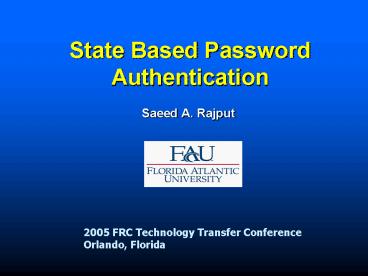State Based Password Authentication - PowerPoint PPT Presentation
1 / 21
Title:
State Based Password Authentication
Description:
Non-Brute force attacks are designed to. reduce attempts: ... Auto-recovery after lapsed time. Addressing 'user forgets password' weakness: ... – PowerPoint PPT presentation
Number of Views:37
Avg rating:3.0/5.0
Title: State Based Password Authentication
1
State Based Password Authentication
- Saeed A. Rajput
2005 FRC Technology Transfer Conference Orlando,
Florida
2
Introduction
- Why is user ID Password based authentication
- so common?
3
Password on-line attack
- Brute-Force Attack
- If alphabet size 95
- And PW Length n 6
- Then PW Space P956 700 x 109
- _at_ 50 million passwords / second, can break it in
2 hours (avg.)
4
Password on-line attack
- Non-Brute force attacks are designed to
- reduce attempts
- Dictionary attack password candidates lt 100,000
- Syllable attack
- Rule-based attack
- Example Say we know that password has 1 or 2
digits - then a rule can generate passwords such as user1,
mind67, snapshot99, etc.
5
Attack Model
- Login sequence
- Single attempt
- Attack Set of all attempts for a given user
- Examples
- Brute Force Attack
- Dictionary Attack
- Attack Complexity --- size of attack
sequence set - Attack infeasibility
- function (Complexity, Policy)
6
Making Authentication Secure
- Attack infeasibility function (Complexity,
Policy) - Two options
- Increase Complexity
- Enforce strong passwords
- Apply more complicated rule
- Example 45Satlk7m234
- Stronger Policy Next Slide----
7
Conventional Defense Policies
- Attack infeasibility function (Complexity,
Policy) - Limit the number of attempts
- Require visual confirmation
- Lock user account for limited time
- Enforce IP/time/location/context restrictions
- Require more personal information
8
Problems Conventional Policies
- Need more information about user ssn
- Cause inconvenience to user longer PW
- Depend on Lockouts out of control
- Need to provide help desk
- ?phone call to help desk, 25 per call
9
State increase function f(i) Linear
- We have seen this example already.
- f (i) k i max k
- f (i) max i i gt max k
10
State Increase function f (i)
- Non-linear function Example
11
Why non-linear function?
- Better UsabilitySecurity trade-off
- (a) Increases Attack infeasibility
- Many failed attempts gt high state
- New infeasibility vnew vold x max x k
- (b) Tolerates error
- For first few failed attempts
- small state transitions gt convenience
12
f (i) L e a i ?, a 1
13
Advantages
- Increase attack infeasibility
- v new v old x max x k
- Flexible Policies using single/simple approach
- Strong passwords not needed
- Additional personal information not required
- User can self -recover account
- Reduces password resetting help-desk phone calls
14
Commercial Impact
- Easy to implement into the authentication system.
Simple algorithm - Flexible Security Policies
- Same authentication mechanism can be used for
strict as well as liberal access with no need to
find new tricks to enhance security. - Reduces expensive upgrades when security policies
change or new critical systems are added to an
enterprise. - Easy for user only the PW is needed
- Reduce help desk cost
15
The Team
- Presenter Saeed Rajput, Ph.D. CISSP
- 8 years of experience in information security and
security systems architecture. - Past work Experience
- Cerebit, Inc.(VP), eTrango (Director), Racal
Datacom (Security Architect), Skylight Software
(Director) TimeWarner (Consultant) - Selected Patent
- US6401206 "Method and Apparatus for Binding
Electronic Impressions Made by Digital Identities
To Documents," Issued June 4, 2002. - Education
- Ph.D. USC, Electrical Engineering (Digital
Communications)
16
The Team
- Jihong Chen
- 3 years of multidisciplinary experience including
system management and software development - Graduate Student at FAU
- Publication
- State Based Authentication, the 43rd ACMSE
conference, 2005 - Education
- MSC, FAU, Computer Science.
17
The Team
- Sam Hsu
- Associate Professor, Department of Computer
Science and Engineering, Florida Atlantic
University. - Research interests
- Web Technologies, Computer Networking, Web-based
Distance Learning. - Also interested in projects that have practical
and educational applications - Publications
- Has published over 40 refereed papers in the
related fields in the past few years. - Education
- Ph.D. FAU, Computer Engineering, 1993
18
Target Industries
- Any application that requires password based user
authentication. - Examples of applications
- Web logins
- Computer logins
- Network login
- Protect access to physical resources (key pads)
- ATM machine login
- How to incorporate the technology
- Modification to the authentication source code.
19
Technology Status
- Developed and working
- Patent Pending
- Weakness
- Long wait by the user
- What if user forgets password
20
Addressing the two weaknesses
- Addressing Long wait by the user weakness
- Automatic aid to recovery
- Software
- Hardware
- Auto-recovery after lapsed time
- Addressing user forgets password weakness
- Provide a password hint so users do not forget
their password.
21
State Based Password Authentication
- For Further Information
- Today
- Saeed Rajput, Jeanie L. McGuire or Steve Nappi
- at the FAU booth or
- After the conference
- Steve Nappi
- 561-297-1165 or snappi_at_fau.edu
- Office of Technology Transfer































